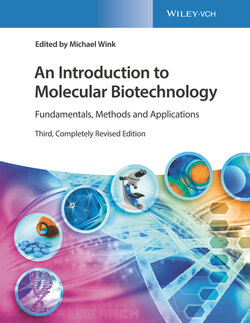Читать книгу An Introduction to Molecular Biotechnology - Группа авторов - Страница 38
4.1 Genomes, Chromosomes, and Replication
ОглавлениеIn the past few decades, genomics has developed into a new specialized area of genetics and biotechnology. The aim is the complete molecular and functional characterization of genomes of all important organisms. It is divided into structural and functional genomics (see Chapter 21). When the human genome project HUGO (Human Genome Organization) determined the nucleotide sequence of a human haploid chromosome in 2001, this was a real breakthrough. Since then, sequencing technologies have changed. Instead of cloning and sequencing individual genes, today complete genomes are determined by massive parallel sequencing using next generation sequencing (NGS) (see Chapters 14 and 21). More than 1150 other genomes are already completely sequenced (as of 2010), including 100 genomes of Eukarya, 970 of Bacteria, and 70 of Archaea (Table 4.1). In 2020, the number of species with sequenced genomes is higher than 10000 (see https://en.wikipedia.org/wiki/List_of_sequenced_bacterial_genomes, https://en.wikipedia.org/wiki/List_of_sequenced_eukaryotic_genomes for an update) and new sequenced are published every eeek. By comparing nucleotide sequences and derived amino acid sequences obtained from various organ‐ and tissue‐specific cDNA and expressed sequence tag(EST) banks, or through the construction of knockout RNAi, or antisense mutants, assigning the genomic sequences to functional units or genes is being attempted. Finally, functional genomics (see Chapters 21 and 22) will supply an exact answer to the question of which regions of the genome have a function (today it is estimated that the information necessary for survival constitutes 85–95% of bacteria and only 10% of the whole DNA for vertebrates) and which parts can be regarded as apparently functionless evolutionary remnants. However, parts of the genome, which were considered functionless a few years ago, do have functions.
Table 4.1 Overview of a few of the genomes that are already sequenced and published.
| Organism | Size (Mb) |
|---|---|
| Archaebacteria | |
| Archaeoglobus fulgidus | 2.18 |
| Methanobacterium thermoautotrophicum | 1.75 |
| Methanococcus jannaschii | 1.66 |
| Pyrococcus horikoshii | 1.80 |
| Eubacteria | |
| Bacillus subtilis (Gram‐positive bacterium) | 4.21 |
| Borrelia burgdorferi (borreliosis pathogen) | 1.44 |
| Chlamydia trachomatis (pathogen of urogenital tract) | 1.05 |
| Escherichia coli (intestinal bacterium) | 4.64 |
| Haemophilus influenzae (pathogen of purulent throat infections) | 1.83 |
| Helicobacter pylori (stomach ulcer pathogen) | 1.67 |
| Mycobacterium tuberculosis (tuberculosis pathogen) | 4.45 |
| Mycoplasma pneumoniae (pneumonia pathogen) | 0.81 |
| Rickettsia prowazekii (typhus fever pathogen) | 1.10 |
| Treponema pallidum (syphilis pathogen) | 1.14 |
| Eukaryotes | |
| Plasmodium falciparum (malaria pathogen) | 1.00 |
| Saccharomyces cerevisiae (Brewer's yeast) | 12.069 |
| Arabidopsis thaliana (Arabidopsis) | 220 |
| Caenorhabditis elegans (nematode) | 130 |
| Drosophila melanogaster (fruit fly) | 200 |
| Mus musculus (house mouse) | 2800 |
| Homo sapiens (human) | 3200 |
Mb, one million bases.
